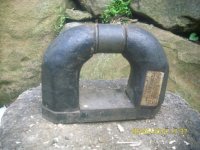One of them lives in my living room. The multicavity magnetron was invented in England shortly before WWII. Churchill realized that England didn't have the facilities to properly develop it so he put a scientist named Tizard and a number of scientists who worked with him along with some tubes on a ship to the US. Churchill's instructions were that they were to tell the Americans everything. This was not a quid pro quo, but a complete disclosure in the hopes that the Americans would reciprocate. When the English told the Americans how much power they got from the magnetron, the Americans all but outright called them liars. The English response was "Well test the bloody thing!" In those days we had GE, Westinghouse, Bell Labs, Raytheon, RCA and others in the area and Eitel McCollugh and Litton on the West Coast where we actually made things instead of shipping the work to China. The Americans took a magnetron to one of the labs and came back almost in shock. It really did it. One of the American scientists said afterward that he sat there realizing that all the things they had fantasized about were suddenly possible. The Americans put their tremendous resources on the project and soon were producing magnetrons with a million watt peak outputs.
They made airborne RADAR sets, but were very concerned about the Germans capturing one. They tried thermite bombs to destroy them but there was still enough left to reconstruct. A B24 was shot down over Rotterdam and the Germans copied the magnetron. I had a German LMS1 magnetron but sold it when money got tight.
When I was a 19 year old experimenting with VHF radio, the MIT Radiation Lab Series, produced by the scientists who developed RADAR, was my guru. I had to drive to the St. Louis Public Library and read it there because they would not let me check a volume out. Now I have my own, all 3 feet of shelf space.
The descendants of these magnetrons now heat your coffee in microwave ovens.
The black object to the left of the magnet is a magnetron similar to the one that would be between the poles of the magnet. The large object in the back is a low frequency magnetron, as is the blue gray one at the extreme left.
Reading the accounts in the RadLab Series, one thing that is impressive is that they could have anything they asked for, just for the asking. We had the facilities and skills to make almost anything. Where are they now?
Bill
 I have two sets of these. Very strong, roughly quarter-circle magnets, with a base and keeper to separate/link trhe small ends. The one pictured I acquired at a yard sale, and the magnets appear to be coated with some sort of cloth and varnish. A very similar set I have from my father has the magnets encased in aluminum, except for the 90 deg ground pole faces. He worked with 1940's era radio equipment, so they may have some connection to that.I use them mostly for finding parts dropped in the grass.
I have two sets of these. Very strong, roughly quarter-circle magnets, with a base and keeper to separate/link trhe small ends. The one pictured I acquired at a yard sale, and the magnets appear to be coated with some sort of cloth and varnish. A very similar set I have from my father has the magnets encased in aluminum, except for the 90 deg ground pole faces. He worked with 1940's era radio equipment, so they may have some connection to that.I use them mostly for finding parts dropped in the grass.




 If you want to see a much smaller version of a cavity magnetron than these magnets used, just take apart a microwave.
If you want to see a much smaller version of a cavity magnetron than these magnets used, just take apart a microwave.